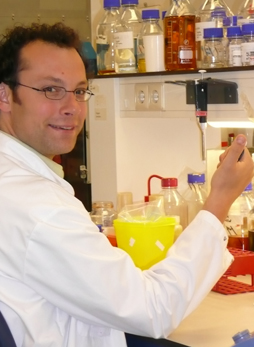Investments in Young Researchers Pay Off
Krim Fellows Embark on Independent Careers in AIDS Research

Following his Krim Fellowship,
Rogier Sanders was appointed
to a tenure-track post and
received a prestigious grant.
|
May 2011— More than three years after amfAR launched the Mathilde Krim Fellowships in Basic Biomedical Research, many of the young scientists who received these prestigious awards are achieving impressive success. In an era when support for early-career scientists is drying up, these researchers are making extraordinary progress on a wide range of projects. They have also been able to leverage their amfAR funding to apply for larger grants to sustain their work, and are establishing careers as independent researchers at prestigious institutions.
Among the first Krim Fellows were Rogier Sanders, Ph.D., and Felipe Diaz- Griffero, Ph.D. Both researchers have since been appointed to tenure-track positions—a path made easier, they say, by their Krim Fellowships—and both subsequently received Phase II Krim funding from amfAR, which supported their research for an additional year.
“It’s really difficult to start an independent career as a researcher, and the transition from postdoc to junior faculty is especially challenging,” said Dr. Sanders, who is using HIV’s own process of evolution to design a potential HIV vaccine. “There were a few times during the past few years when I thought about quitting science and finding a job in the private sector. At a critical moment in my career, the Krim Fellowship helped me move forward.” He became an assistant professor at the University of Amsterdam in late 2009, and subsequently received a Vidi grant, the most prestigious career development grant for junior faculty in the Netherlands.
For Dr. Diaz-Griffero, whose studies of a protein that blocks HIV in monkeys may aid in the development of new treatments in humans, the amfAR funding he received while at the Dana-Farber Cancer Institute also helped him move to the next stage of his career. “When I got the Krim Fellowship, I was able to gather data that enabled me to apply for NIH funding, which is helping to support my research over the next five years,” he explained. It also helped him obtain a junior faculty position at Albert Einstein College of Medicine, where his Phase II amfAR funding was “essential in my first year,” he said.
Just a year after Thomas Gramberg, Ph.D., received a Krim Fellowship to conduct research on the cell biology of HIV at New York University, he has already moved to the tenure track. Dr. Gramberg said that amfAR support was “very helpful” in obtaining his current job as a junior professor at the Institute for Virology at the University of Erlangen-Nuremberg in his native Germany—a highly prestigious position.

Navid Madani’s research into a vaginal microbicide is now
continuing with support from
the NIH.
|
For Navid Madani, Ph.D., receiving a Krim Fellowship in 2009 enabled her to use innovative strategies to test potential ingredients for a vaginal microbicide to prevent HIV infection. “We didn’t have many preliminary results,” she explained, “and I was working outside the box with my hypotheses.” amfAR funding gave Dr. Madani an opportunity to gather preliminary data using three new technologies to identify new HIV-blocking compounds.
Dr. Madani is continuing her research at Dana-Farber with funding from the NIH, for which she was able to apply using the results from her amfAR-supported studies. “To be able to make a small contribution to the development of a female-controlled prevention method like microbicides is wonderful for me,” she said.
Another 2009 Krim Fellow, Alberto Bosque, Ph.D., called the fellowship “an incredible opportunity.” Dr. Bosque, whose study of a test-tube model recreating HIV’s hidden reservoirs was published this winter in the journal Methods, was recently offered a position on the University of Utah’s faculty as a research associate professor. He and his colleagues are now adapting their test-tube model so that it can be used to screen possible compounds for use in drugs to flush out latent HIV.
As HIV/AIDS researchers move closer to solving some of the key mysteries about how the virus works, how it can be blocked from becoming established in the body, and even how it might be eradicated, the continual infusion of talent and bold new thinking remains crucial. “The successes we’ve seen so far from Krim Fellows have shown that a relatively small investment in the careers of young scientists can have a tremendous impact, reinvigorating the field with new ideas,” said Rowena Johnston, Ph.D., amfAR’s vice president and director of research.
Related stories: